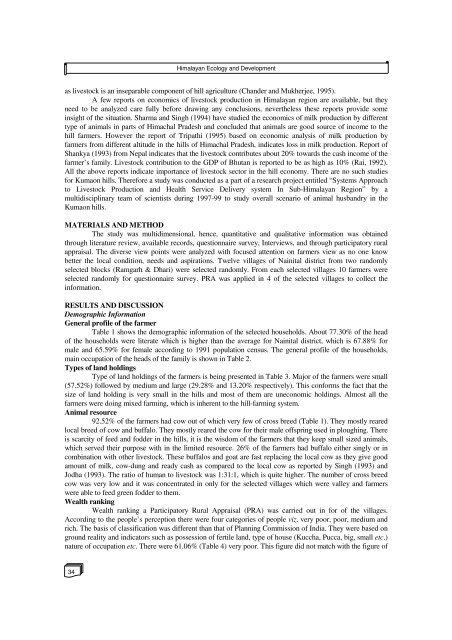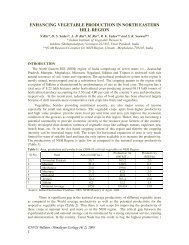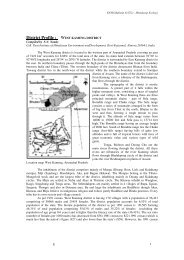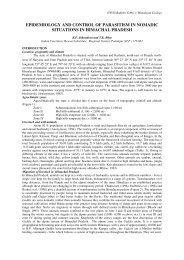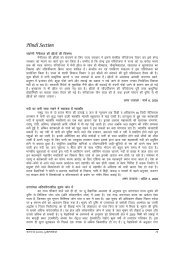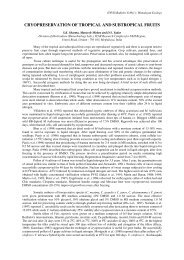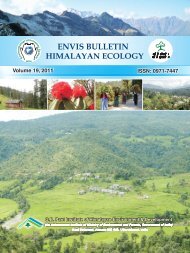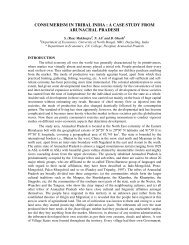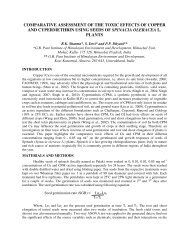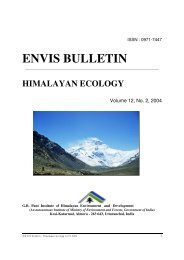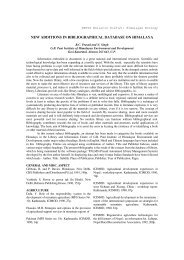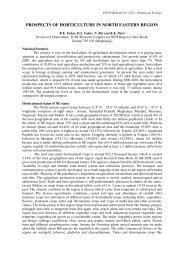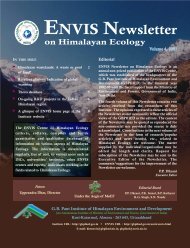Complete PDF - ENVIS Centre on Himalayan Ecology
Complete PDF - ENVIS Centre on Himalayan Ecology
Complete PDF - ENVIS Centre on Himalayan Ecology
You also want an ePaper? Increase the reach of your titles
YUMPU automatically turns print PDFs into web optimized ePapers that Google loves.
<strong>Himalayan</strong> <strong>Ecology</strong> and Development<br />
as livestock is an inseparable comp<strong>on</strong>ent of hill agriculture (Chander and Mukherjee, 1995).<br />
A few reports <strong>on</strong> ec<strong>on</strong>omics of livestock producti<strong>on</strong> in <strong>Himalayan</strong> regi<strong>on</strong> are available, but they<br />
need to be analyzed care fully before drawing any c<strong>on</strong>clusi<strong>on</strong>s, nevertheless these reports provide some<br />
insight of the situati<strong>on</strong>. Sharma and Singh (1994) have studied the ec<strong>on</strong>omics of milk producti<strong>on</strong> by different<br />
type of animals in parts of Himachal Pradesh and c<strong>on</strong>cluded that animals are good source of income to the<br />
hill farmers. However the report of Tripathi (1995) based <strong>on</strong> ec<strong>on</strong>omic analysis of milk producti<strong>on</strong> by<br />
farmers from different altitude in the hills of Himachal Pradesh, indicates loss in milk producti<strong>on</strong>. Report of<br />
Shankya (1993) from Nepal indicates that the livestock c<strong>on</strong>tributes about 20% towards the cash income of the<br />
farmer’s family. Livestock c<strong>on</strong>tributi<strong>on</strong> to the GDP of Bhutan is reported to be as high as 10% (Rai, 1992).<br />
All the above reports indicate importance of livestock sector in the hill ec<strong>on</strong>omy. There are no such studies<br />
for Kuma<strong>on</strong> hills. Therefore a study was c<strong>on</strong>ducted as a part of a research project entitled “Systems Approach<br />
to Livestock Producti<strong>on</strong> and Health Service Delivery system In Sub-<strong>Himalayan</strong> Regi<strong>on</strong>” by a<br />
multidisciplinary team of scientists during 1997-99 to study overall scenario of animal husbandry in the<br />
Kuma<strong>on</strong> hills.<br />
MATERIALS AND METHOD<br />
The study was multidimensi<strong>on</strong>al, hence, quantitative and qualitative informati<strong>on</strong> was obtained<br />
through literature review, available records, questi<strong>on</strong>naire survey, Interviews, and through participatory rural<br />
appraisal. The diverse view points were analyzed with focused attenti<strong>on</strong> <strong>on</strong> farmers view as no <strong>on</strong>e know<br />
better the local c<strong>on</strong>diti<strong>on</strong>, needs and aspirati<strong>on</strong>s. Twelve villages of Nainital district from two randomly<br />
selected blocks (Ramgarh & Dhari) were selected randomly. From each selected villages 10 farmers were<br />
selected randomly for questi<strong>on</strong>naire survey. PRA was applied in 4 of the selected villages to collect the<br />
informati<strong>on</strong>.<br />
RESULTS AND DISCUSSION<br />
Demographic Informati<strong>on</strong><br />
General profile of the farmer<br />
Table 1 shows the demographic informati<strong>on</strong> of the selected households. About 77.30% of the head<br />
of the households were literate which is higher than the average for Nainital district, which is 67.88% for<br />
male and 65.59% for female according to 1991 populati<strong>on</strong> census. The general profile of the households,<br />
main occupati<strong>on</strong> of the heads of the family is shown in Table 2.<br />
Types of land holdings<br />
Type of land holdings of the farmers is being presented in Table 3. Major of the farmers were small<br />
(57.52%) followed by medium and large (29.28% and 13.20% respectively). This c<strong>on</strong>forms the fact that the<br />
size of land holding is very small in the hills and most of them are unec<strong>on</strong>omic holdings. Almost all the<br />
farmers were doing mixed farming, which is inherent to the hill-farming system.<br />
Animal resource<br />
92.52% of the farmers had cow out of which very few of cross breed (Table 1). They mostly reared<br />
local breed of cow and buffalo. They mostly reared the cow for their male offspring used in ploughing. There<br />
is scarcity of feed and fodder in the hills, it is the wisdom of the farmers that they keep small sized animals,<br />
which served their purpose with in the limited resource. 26% of the farmers had buffalo either singly or in<br />
combinati<strong>on</strong> with other livestock. These buffalos and goat are fast replacing the local cow as they give good<br />
amount of milk, cow-dung and ready cash as compared to the local cow as reported by Singh (1993) and<br />
Jodha (1993). The ratio of human to livestock was 1:31:1, which is quite higher. The number of cross breed<br />
cow was very low and it was c<strong>on</strong>centrated in <strong>on</strong>ly for the selected villages which were valley and farmers<br />
were able to feed green fodder to them.<br />
Wealth ranking<br />
Wealth ranking a Participatory Rural Appraisal (PRA) was carried out in for of the villages.<br />
According to the people’s percepti<strong>on</strong> there were four categories of people viz. very poor, poor, medium and<br />
rich. The basis of classificati<strong>on</strong> was different than that of Planning Commissi<strong>on</strong> of India. They were based <strong>on</strong><br />
ground reality and indicators such as possessi<strong>on</strong> of fertile land, type of house (Kuccha, Pucca, big, small etc.)<br />
nature of occupati<strong>on</strong> etc. There were 61.06% (Table 4) very poor. This figure did not match with the figure of<br />
34


